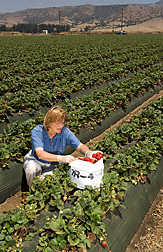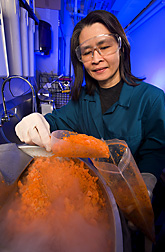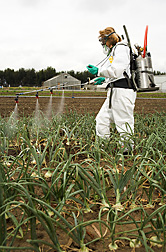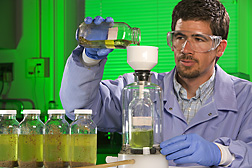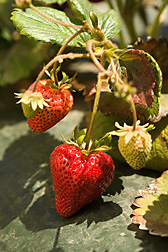Specialty Crops
More Vulnerable Than You Think
|
|
Holiday meals and decorations are always special, and specialty crops are a big part of what makes our seasonal holidays memorable.
It’s hard to find anything on the table that isn’t the result of the work of specialty crop growers—from potatoes, cranberry sauce, wine, and pumpkin or sweetpotato pie to the nutmeg, cinnamon, and herbs that season the dishes. And don’t forget the decorations—from Christmas trees and wreaths to mistletoe and poinsettias, all grown by U.S. specialty crop growers.
Of course, thousands of U.S.-grown specialty crops are important to us not only at holiday time, but also year-round. So it’s surprising that many of these crops are periodically just a pesticide registration or two away from extinction.
It is only IR-4 (Interregional Research Project No. 4) that stands between this disaster and the specialty crop industry.
Back in 1963, the directors of the state agricultural experiment stations (SAES) recognized the needs of the specialty crops industry when they established IR-4, headquartered at the New Jersey Agricultural Experiment Station at Rutgers University.
|
|
The Agricultural Research Service (ARS) began the federal program in 1976 to support the state IR-4 program. The ARS program contributes to the state program by providing data from field and greenhouse studies of food crops and nonfood crops each year, as well as from lab studies of pesticide residue in food crops.
While the state IR-4 program, supported by USDA’s Cooperative State Research, Education, and Extension Service (CSREES), carries the heavier responsibility for the overall IR-4 program, ARS plays a major role by assisting in development of data that contributes toward the pesticide clearances for crops.
ARS provides funding for IR-4 at about $3.5 million a year; CSREES provides about $11 million.
It’s money well spent. IR-4’s research brings savings to farmers in labor costs and decreased yield loss due to pest damages. It is estimated these savings are worth billions of dollars per year. In fact, the Michigan State University Center for Economic Analysis recently concluded that IR-4 contributes $7.675 billion annually to the U.S. gross domestic product.
The goal of IR-4 is to ensure that all specialty crop growers have access to pesticides that are critical to economic survival. More and more, IR-4 works on ever-safer pesticides, including ones that rely on biological controls such as beneficial fungi and insects.
By listening to growers, scientists, and extension personnel, IR-4 learns firsthand of pest-management needs and prioritizes research accordingly. IR-4 then works together with the U.S. Environmental Protection Agency (EPA) and agribusiness to meet these needs.
Trucked In for Lab Analyses
IR-4 maintains seven pesticide-residue labs (three are ARS) responsible for testing residue on food crops. The labs analyze harvested and frozen plant samples received from fields and greenhouses.
ARS physical scientist Emy Pfeil, working with another chemist and technician, directs the pesticide residue testing lab at Beltsville, Maryland. “The 3 ARS labs divide samples from about 120 field trials a year,” Pfeil says. “Each sample must weigh between 4 and 6 pounds, so the samples are often pieces—such as a quarter or half a head of lettuce—of a wide variety of fresh produce.”
Pfeil is proud of her lab’s contribution to IR-4 because she knows that stricter regulations are emptying farmers’ toolboxes of available pest controls and that growers are eager to have new ones.
Because many of the nation’s specialty crops are grown in EPA-defined Region 10 (California and small portions of Arizona and New Mexico), IR-4 conducts hundreds of trials there.
Scientists in ARS’s Crop Improvement and Protection Research Unit at Salinas, California, conduct field trials of pesticides applied on a wide range of food crops, from baby greens, fresh peas, and strawberries to herbs, such as basil, coriander, and dill. Scientists at the Salinas unit have been scrutinizing the effects of insecticides, fungicides, and herbicides on crops for more than 20 years.
|
|
The Application Technology Research Unit in Wooster, Ohio, is another example of an ARS field research unit conducting IR-4 trials. The lab, together with facilities at Ohio State University-Wooster, is uniquely qualified to measure pesticide residue left on crops by various applications. The Wooster group works with food crops and nonfood ones, such as trees, shrubs, flowers, and turfgrass. They also work closely with grower organizations, such as the American Nursery & Landscape Association in Washington, D.C.
“IR-4 is critical to our industry,” says the association’s director of research and regulatory affairs, Marc Teffeau. “It has become even more important as we struggle to deal with a growing influx of foreign pests.”
Because of collaborations like these, IR-4 is now involved in about half the pesticide registrations approved by EPA for new food-crop uses each year.
Selling by the Acre
IR-4’s unique partnership with state universities, grower and commodity groups, registrants, EPA, and USDA helps enable the nation’s $46-billion-a-year horticultural and ornamental plant industry to survive. It costs $100,000 to add just one food crop to an existing pesticide’s registration. “While registration costs less for ornamentals and other nonfood crops, it’s still a lengthy and expensive process,” says Paul Schwartz, coordinator of the ARS IR-4 program.
“The specialty crop industry creates as much sales money as the top major crops combined,” says Jerry J. Baron, IR-4 executive director at Rutgers. “Despite this, the pesticide industry can’t afford the cost to develop and register pesticides for specialty crops. The return on investment doesn’t warrant it. Instead, they focus on corn, soybeans, and wheat,” he says. Those three crops alone occupy about 210 million U.S. acres a year, while hundreds of specialty crops together occupy only 10 million acres. Since pesticides sell by the acre, the problem is simple: “The companies can’t make up their costs through sales for these crops,” Baron says.
|
|
It’s the Law
In hindsight, the SAES directors who began IR-4 seem especially prescient, considering the fact that in 1972, the Federal Insecticide, Fungicide, and Rodenticide Act shook up the specialty crop industry by outlawing the use of pesticides on these crops when the pesticide label doesn’t specifically approve the use on that particular crop. The 1996 Food Quality Protection Act gave similar jolts to the industry, with more stringent pesticide residue requirements that would soon remove, or severely curtail, some of the most effective specialty crop pesticides.
Regulatory approval of pesticides for use on food crops is the single largest IR-4 effort. Each year, program participants prioritize requests for pesticide-registration assistance.
One recent request was from farmer Bruce Buurma, president of Buurma Farms and member of the IR-4 Commodity Liaison Committee. He grows about 40 different vegetables in 3 states on 2,500 acres. Cilantro is Buurma’s version of a big crop, and he grows 130 acres a year on his farm in north-central Ohio. The farm sits on muck soils, where herbicides don’t work on weeds in his cilantro or in his 150 acres of green onions. He has to pay for the crops to be weeded by hand. “Our hand-weeding costs are up 35 percent this year due to wage increases,” Buurma says.
|
|
Buurma communicated this to the agrichemical industry during an annual IR-4 Food Use Workshop. He convinced Dow AgroSciences, Indianapolis, Indiana, to work on adding green onions to the label for oxyfluorfen, a herbicide currently registered for dry onions only.
While Buurma waits for that addition, IR-4 has begun the request process for three other herbicides for cilantro.
Another example of IR-4’s benefit to growers, cited by Cristi Palmer, IR-4 Ornamental Horticulture Program manager, is EPA’s approval last year of Insignia (pyraclostrobin) for use on ornamentals. That approval was based on IR-4 data. Insignia is a fairly new fungicide previously approved for use only on turfgrass. Requested by growers to control Phytophthora diseases in azaleas and rhododendrons, Insignia is now available for use against numerous diseases on many ornamentals, including tulips and other bulbs.
It’s stories like these that prove IR-4’s commitment to U.S. specialty crops and growers. “IR-4 is one of the reasons we have the safest food supply in the world,” says Baron. “The program supplies EPA with the data needed to ensure safety in specialty crops. These crops are the fruits, vegetables, nuts, herbs, and ornamentals that sustain and enrich our lives.”—By Don Comis, Agricultural Research Service Information Staff.
This research is part of Crop Production (#305) and Plant Diseases (#303), two ARS national programs described on the World Wide Web at www.nps.ars.usda.gov.
To reach scientists featured in this article, contact Don Comis, USDA-ARS Information Staff, 5601 Sunnyside Ave., Beltsville, MD 20705-5129; phone (301) 504-1625, fax (301) 504-1486.
"Specialty Crops: More Vulnerable Than You Think" was published in the October 2007 issue of Agricultural Research magazine.







